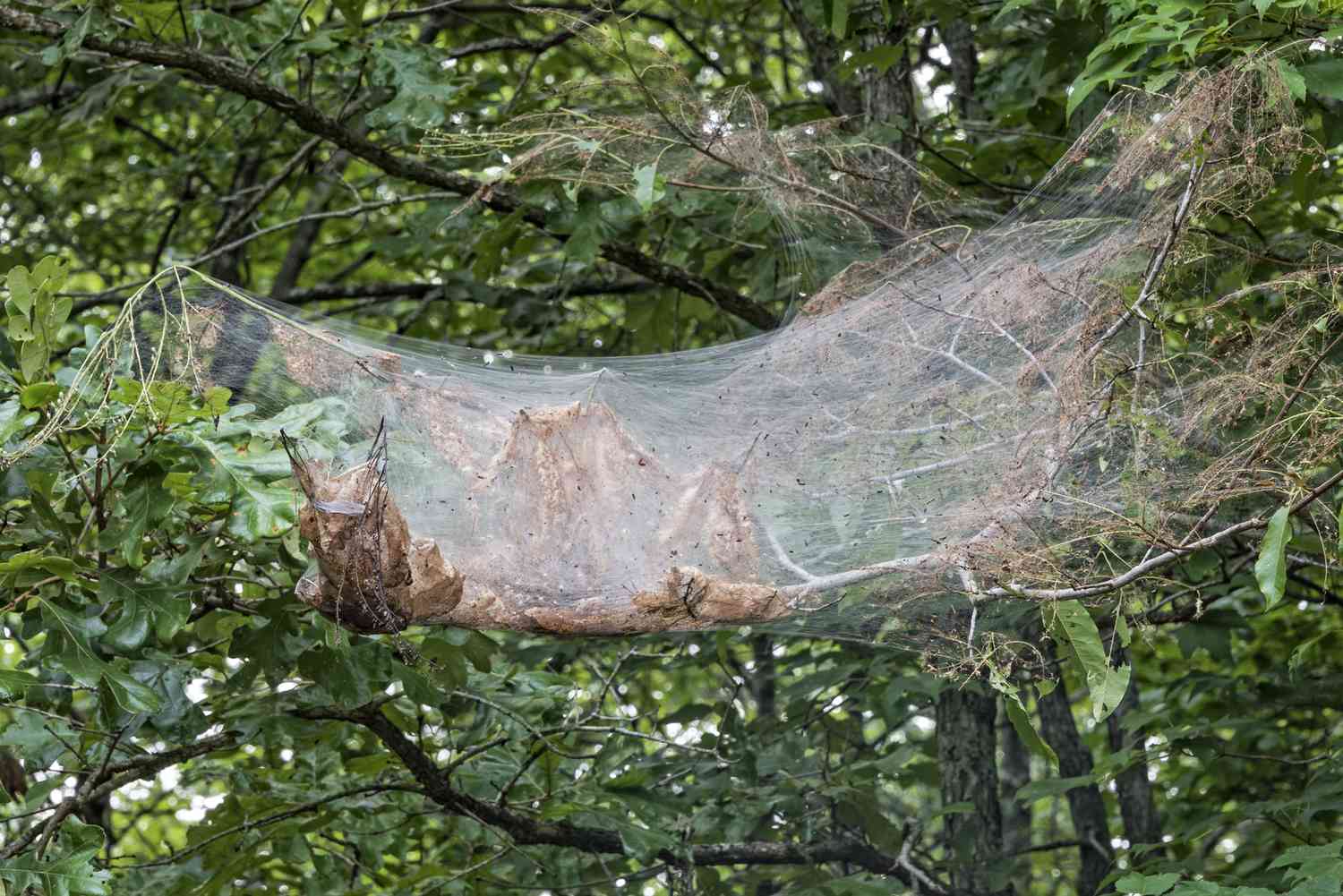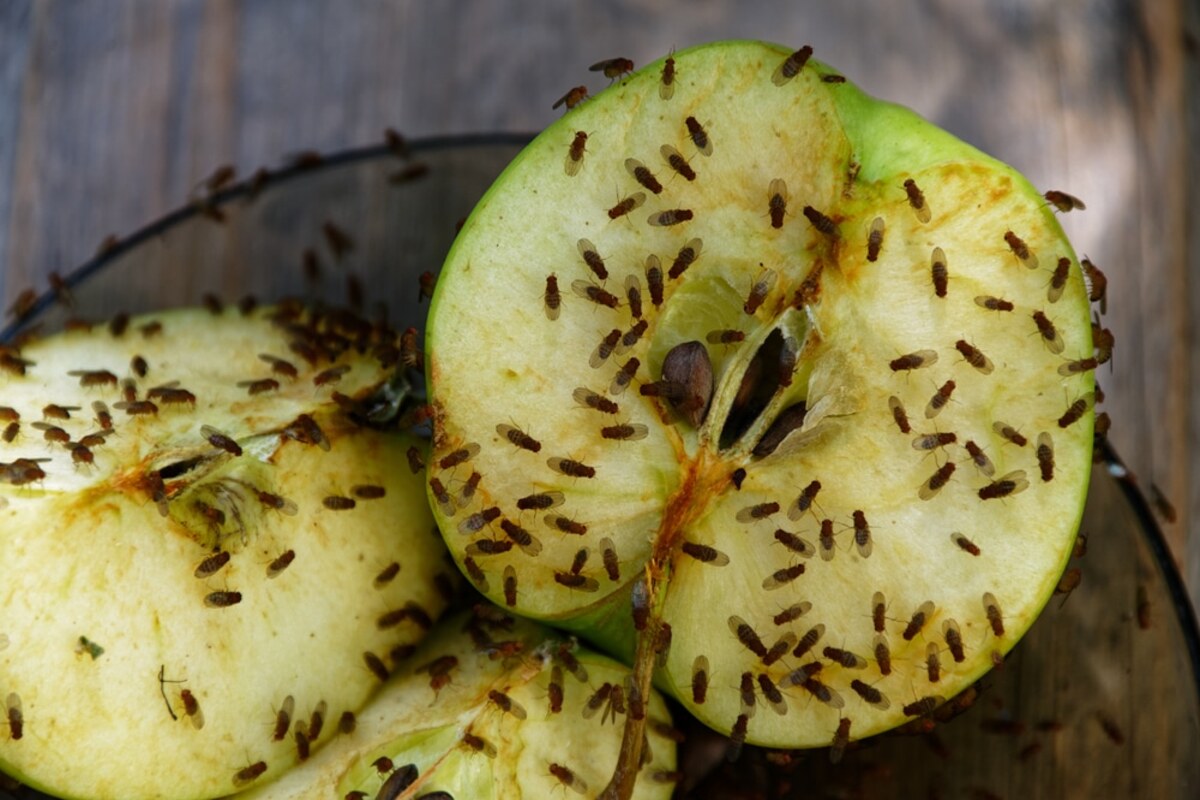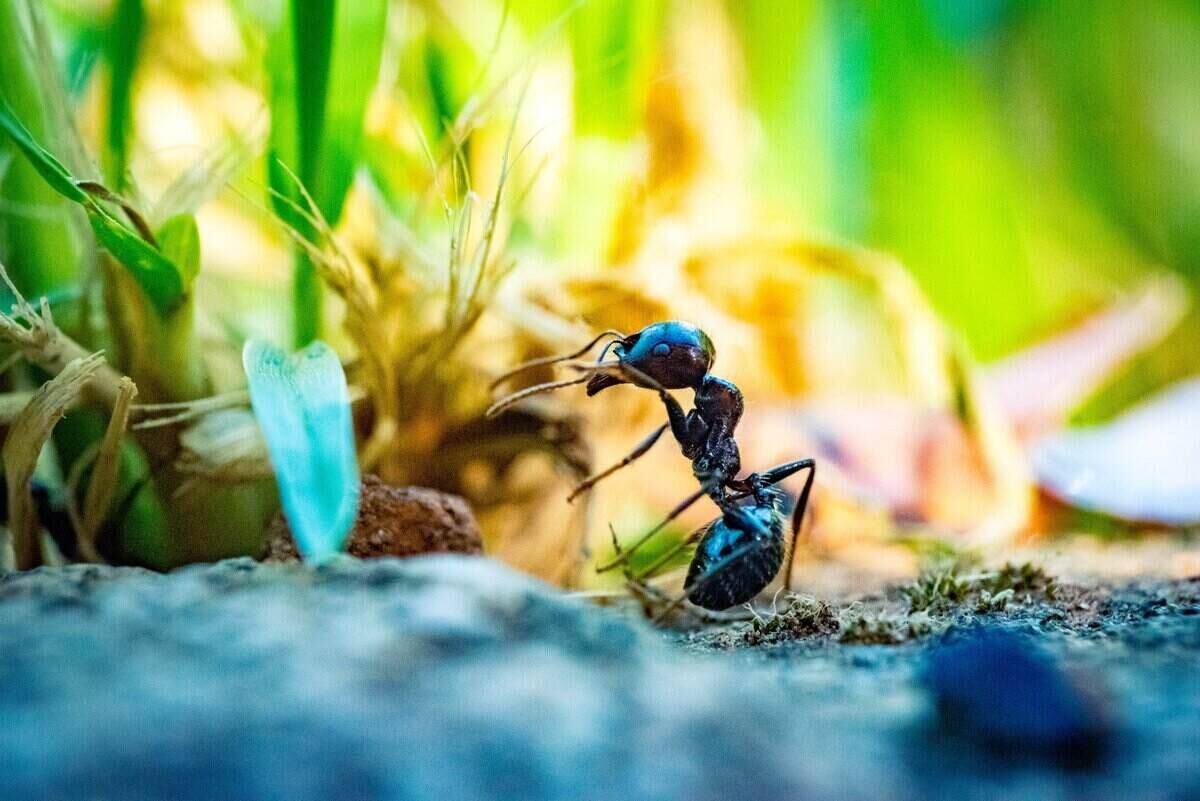Home>Gardening Tips and Tricks>Problem Solving>How To Get Rid Of Webs In Trees


Problem Solving
How To Get Rid Of Webs In Trees
Modified: January 22, 2024
Learn effective problem-solving techniques to eliminate webs in trees. Discover step-by-step methods and tools to safely remove spider webs from your trees and restore their beauty.
(Many of the links in this article redirect to a specific reviewed product. Your purchase of these products through affiliate links helps to generate commission for Chicagolandgardening.com, at no extra cost. Learn more)
Table of Contents
- Introduction
- Understanding Spider Webs in Trees
- Examining the Effects of Spider Webs on Trees
- Factors Contributing to the Development of Spider Webs in Trees
- Assessing the Health Risks Associated with Spider Webs in Trees
- Identifying Tree Species Prone to Spider Web Infestation
- Natural Methods to Remove Spider Webs from Trees
- Chemical Solutions for Eliminating Spider Webs in Trees
- Preventing Spider Web Infestation in Trees
- Conclusion
Introduction
Spider webs in trees can be a fascinating sight, adding a touch of mystery and beauty to the natural environment. However, they can also have negative effects on the health and growth of trees if left unchecked. If you’ve noticed an abundance of spider webs in your trees, you may be wondering how to get rid of them effectively.
In this article, we will explore the reasons behind the development of spider webs in trees, the potential risks they pose, and the various methods you can utilize to remove them. Whether you are a homeowner or a professional arborist, understanding how to address this issue is crucial for maintaining the health and aesthetic appeal of your trees.
While spiders play an important role in nature by controlling insect populations, their webs can become problematic if they cover a large area or interfere with the tree’s functions. Excessive spider webs can obstruct sunlight from reaching the leaves, affecting photosynthesis and impeding healthy growth. Additionally, the accumulation of spider webs can create a breeding ground for other pests such as mites and fungi, further compromising the tree’s vitality.
Fortunately, there are both natural and chemical methods available to remove spider webs from trees. We will explore these methods further in this article, providing you with useful guidance on how to approach this issue based on your situation and preferences.
By implementing the appropriate techniques, you can ensure your trees remain vibrant and free from the negative impacts of spider web infestations. So, let’s dive deeper into the world of spider webs in trees and discover how to effectively deal with them.
Understanding Spider Webs in Trees
Spider webs are intricate structures created by spiders to serve as a home and a means to catch prey. They are made up of silk threads produced by the spider’s spinnerets, specialized glands located on their abdomen. While spiders commonly spin their webs between branches and vegetation, sometimes they can become more prevalent in specific trees.
There are several reasons why spiders may choose to create webs in trees. First, trees offer a higher vantage point for the spiders to detect potential prey. Being elevated allows them to capture flying insects, as well as those climbing up the trunk or branches. Additionally, trees provide stability and support for the web, allowing it to be sturdy and effective in catching prey.
Furthermore, spider webs in trees can be influenced by environmental factors. Certain tree species may attract more spiders due to their specific characteristics, such as bark texture, leaf density, or insect activity. Additionally, the presence of other food sources, such as aphids or other small insects, can attract spiders to trees.
It’s important to note that not all spider webs in trees are harmful or problematic. In fact, they can contribute positively to the ecosystem by controlling insect populations, acting as a natural form of pest control. However, when spider webs become excessive and hinder the tree’s health and growth, proactive measures may be necessary to manage the situation.
When observing spider webs in trees, it’s essential to identify the specific type of spider present. Some spiders are harmless, while others may pose a risk to humans or pets. If you encounter spiders that may be venomous or aggressive, it’s best to seek professional assistance for their safe removal.
In the next sections, we will delve into the effects of spider webs on trees, assess the health risks associated with spider webs, and explore methods to remove and prevent spider web infestations. Let’s continue our journey into the world of spider webs in trees.
Examining the Effects of Spider Webs on Trees
While spider webs can be visually intriguing, they can have negative effects on trees if they become excessive or cover a significant portion of the foliage. Understanding these effects is crucial for implementing appropriate measures to address the issue.
One of the primary concerns with spider webs in trees is their ability to obstruct sunlight. Trees rely on photosynthesis to produce energy and grow, and when spider webs block sunlight from reaching the leaves, it can impede this vital process. As a result, the tree may experience stunted growth and reduced overall health.
Additionally, excessive spider webs can interfere with the tree’s ability to exchange gases, such as oxygen and carbon dioxide, through the leaf surface. This can disrupt the tree’s respiratory processes, leading to further declines in its overall health and vigor.
Furthermore, the accumulation of spider webs can create an ideal environment for other pests, such as mites and fungi, to thrive. These secondary infestations can further weaken the tree and cause additional damage. For example, mites can feed on the tree’s sap, depriving it of essential nutrients, while fungi can cause diseases and decay.
It’s also worth noting that spider webs can impact the aesthetic appeal of trees, especially in urban and landscaped areas. Trees covered in dense spider webs can give off an unkempt appearance, detracting from the overall beauty of the landscape.
In summary, spider webs in trees can negatively affect their health and vitality by obstructing sunlight, impeding gas exchange, and creating a favorable environment for pests and diseases. Understanding these effects is essential for taking appropriate action to remove or prevent spider web infestations in trees, which we will explore in the following sections.
Factors Contributing to the Development of Spider Webs in Trees
The development of spider webs in trees can be influenced by various factors, including both biological and environmental aspects. By understanding these factors, you can gain insights into why spider webs may be more prevalent in certain trees.
One of the key factors is the tree species itself. Some trees are more attractive to spiders due to their specific characteristics. For example, trees with rough bark or dense foliage provide ideal surfaces for spiders to anchor their webs. Certain tree species may also attract more insects, which in turn can draw spiders to create their webs in the vicinity.
In addition to the tree species, the overall health and condition of the tree play a role in spider web development. Weaker or stressed trees are more susceptible to infestation, as they may produce fewer natural repellents or attract more insects. Maintaining the health of your trees through proper watering, fertilization, and regular pruning can help reduce the likelihood of spider web formation.
Environmental factors also contribute to the prevalence of spider webs in trees. Spiders are more active in warmer weather, and increased insect activity during spring and summer can lead to higher spider populations. Additionally, the availability of suitable prey and habitat plays a role. If there are ample food sources and suitable locations for web construction near your trees, spider infestations may be more likely.
Moreover, nearby vegetation and landscaping practices can influence spider web development. Tall grass, shrubs, or other structures close to your trees can provide a convenient launching pad for spiders to build their webs. By reducing vegetation and maintaining an open area around your trees, you can minimize the attractiveness of the environment for spiders.
Understanding these factors can help you take preventive measures to minimize spider web infestations in your trees. By selecting tree species that are less attractive to spiders, maintaining tree health, and managing the surrounding environment, you can reduce the likelihood of excessive spider webs and keep your trees in optimal condition.
Assessing the Health Risks Associated with Spider Webs in Trees
When it comes to spider webs in trees, the primary concern for most people is the potential health risks they may pose. While some spiders are harmless, others can be venomous or aggressive, presenting a danger to humans and pets. It’s essential to assess these risks to ensure the safety of all individuals interacting with the trees.
Firstly, it’s important to note that not all spiders found in trees are venomous or aggressive. Most spiders prefer to avoid human contact and will only bite if they feel threatened. However, it’s crucial to be aware of venomous spiders that may inhabit trees, such as black widows or brown recluse spiders. These spiders can deliver venomous bites that require medical attention.
Typically, spider bites in trees occur when individuals unknowingly come into contact with a spider or disturb its web. When a human or animal accidentally brushes against a spider or its web, the spider may bite in self-defense. While most spider bites result in minor symptoms, such as redness, swelling, or itching, venomous bites can cause more severe reactions.
It’s crucial to educate yourself about the venomous spiders in your area and take precautions when dealing with spider webs in trees. If you believe you have been bitten by a venomous spider, it’s important to seek medical attention promptly.
While the health risks associated with spider webs in trees primarily revolve around spider bites, it’s worth mentioning that excessive spider webs can also harbor other pests. These pests, such as mites or fungi, can impact the health of the tree and potentially pose additional risks to humans or pets. Mites can cause skin irritations or allergic reactions, while fungi can release spores that may lead to respiratory issues.
To mitigate the health risks associated with spider webs in trees, it’s advisable to take precautions, especially if you need to remove the webs yourself. Wearing protective clothing, gloves, and using appropriate tools can help minimize the chances of accidental contact with spiders or their bites.
By being aware of the potential health risks associated with spider webs in trees and taking necessary precautions, you can ensure the safety of yourself, your family, and your pets while addressing the issue effectively.
Identifying Tree Species Prone to Spider Web Infestation
While spider webs can be found in various tree species, some trees are more susceptible to infestation than others. By identifying the tree species prone to spider web development, you can implement proactive measures to prevent or address potential infestations early on.
One tree species often associated with spider web infestation is the coniferous tree. Conifers, such as pine, spruce, and fir trees, have dense foliage that provides an ideal environment for spiders to anchor their webs. The branches of coniferous trees also offer stable structures for spiders to construct their intricate webs.
Deciduous trees, such as oak, maple, and birch trees, can also attract spiders. These trees typically have rough bark and a diverse canopy that offers numerous opportunities for web construction. Additionally, the dense foliage of deciduous trees can provide shelter and a potential food source for spiders.
Certain tree characteristics can make them more attractive to spiders. Trees with rough, textured bark provide favorable surfaces for spiders to anchor their webs securely. Likewise, trees with a large number of branches and a dense canopy provide ample space for spiders to construct their webs and capture prey.
Furthermore, the presence of insects can influence spider web infestations in trees. Trees that attract a significant number of insects, such as fruit trees or trees near water sources, are more likely to experience spider web development. Spiders are opportunistic predators and will follow their food sources.
Local climate and geographical location can also play a role in determining which tree species are more prone to spider web infestation. Spiders tend to be more active in warmer climates, and certain regions or habitats may harbor a higher diversity and population of spiders.
It’s important to note that while these tree species are more susceptible to spider web infestation, it doesn’t necessarily mean that all trees of these species will be affected. Environmental factors, such as the availability of prey and suitable web construction locations, also influence the prevalence of spider webs.
By being aware of the tree species that are more prone to spider web infestations, you can closely monitor these trees and implement preventive measures to reduce the likelihood of excessive spider webs and maintain the health and aesthetics of your landscape.
Natural Methods to Remove Spider Webs from Trees
If you prefer to use natural methods to remove spider webs from trees, there are several effective techniques you can employ. These methods aim to eliminate the webs without causing harm to the tree or the environment.
1. Manual Removal: One straightforward approach is to physically remove the spider webs using a long-handled broom or brush. Carefully sweep the webs away, being cautious not to damage the tree’s branches or foliage. This method is best for smaller webs or localized infestations.
2. High-Pressure Water: A strong stream of water can effectively dislodge spider webs from tree branches. Use a hose with an adjustable nozzle or a pressure washer on a low setting to spray the webs away. Be gentle to avoid damaging the tree’s bark or foliage.
3. Natural Predators: Encouraging the presence of natural predators, such as birds or beneficial insects, can help control spider populations and reduce web formation. Providing bird feeders or birdhouses near the infested trees can attract birds that feed on spiders. Additionally, encouraging a diverse ecosystem with a variety of insects will attract their predators.
4. Pruning and Trimming: Regular pruning and trimming can help remove spider webs as well as improve tree health. Remove any branches or twigs that have noticeable infestations to prevent the spread of webs. Opening up the tree’s canopy through pruning can also create an environment less favorable for spider web development.
5. Natural Repellents: Some natural substances, such as essential oils or vinegar solutions, may deter spiders from creating webs. Spray a mixture of water and a few drops of essential oil (peppermint, tea tree, or citrus) onto the affected areas of the tree. Alternatively, a solution of vinegar and water can be used as a deterrent. Test these solutions on a small area first to ensure they do not harm the tree.
It’s important to note that while these natural methods can be effective, they may need to be repeated periodically to prevent the reestablishment of spider webs. Regular inspection and maintenance are key to keeping spider infestations under control.
By utilizing these natural techniques, you can remove spider webs from your trees while minimizing the impact on the tree and creating a healthier environment for both the tree and surrounding ecosystem.
Chemical Solutions for Eliminating Spider Webs in Trees
If natural methods are not yielding the desired results, or if you are dealing with a persistent spider infestation, chemical solutions can be used to effectively remove spider webs from trees. These solutions are designed to target spiders and their webs while minimizing harm to the tree and the surrounding environment.
Before using any chemical solution, it is essential to read and follow the instructions on the product label carefully. Additionally, it’s advisable to wear protective clothing, such as gloves and safety goggles, to prevent contact with the chemical and minimize any potential risks.
1. Insecticidal Soaps: Insecticidal soaps are made from natural fatty acids and are effective in controlling various pests, including spiders. These soaps disrupt the cell membranes of spiders and their eggs, causing their demise. Dilute the soap according to the manufacturer’s instructions and spray it directly onto the spider webs and surrounding areas.
2. Pyrethroid Insecticides: Pyrethroid insecticides are synthetic chemicals that target insects and arachnids, including spiders. They work by affecting the nervous system of the pests, leading to paralysis and eventual death. Ensure that the product you choose is labeled for use on trees and follow the instructions for application.
3. Residual Insecticides: Residual insecticides provide longer-term protection against spider webs. These formulations are applied to the tree’s bark and foliage and remain active for an extended period, eliminating spiders as they come into contact with the treated surfaces. It’s important to choose a product labeled for use on trees and apply it according to the manufacturer’s instructions.
4. Professional Pest Control: If the spider infestation is severe or persistent, it may be necessary to seek assistance from a professional pest control service. Pest control professionals have access to specialized products and techniques to effectively remove spider webs and address the underlying infestation while minimizing risks to the tree and the environment.
Remember, chemical solutions should be used as a last resort and applied judiciously. Care should be taken to avoid any contact with desirable insects (e.g., pollinators) and other wildlife. Additionally, consult local regulations and environmental guidelines before using any chemical treatments.
By following the appropriate precautions and using chemical solutions responsibly, you can effectively remove spider webs from your trees and restore their health and aesthetics.
Preventing Spider Web Infestation in Trees
Prevention is key when it comes to managing spider web infestations in trees. By implementing proactive measures, you can create an environment that is less attractive to spiders, reducing the likelihood of excessive web formation. Here are some effective strategies to prevent spider web infestation in trees:
1. Regular Tree Maintenance: Proper tree maintenance is essential for overall tree health and resilience against pests. Regularly inspect your trees for signs of infestation, such as the presence of spider webs or noticeable pest activity. Prune away dead, damaged, or weak branches to reduce potential web construction sites and enhance air circulation within the tree’s canopy.
2. Manage Vegetation: Keep the area surrounding your trees well-maintained and free from excessive vegetation. Overgrown grass, shrubs, and debris provide hiding places and launching pads for spiders. By keeping the immediate area clean and clear, you can discourage spiders from setting up their webs too close to your trees.
3. Remove Prey Sources: Spiders are attracted to locations with easy access to food. Regularly remove dead leaves, fruits, and other organic debris that can serve as a food source for insects. By reducing the presence of prey, you can make your trees less appealing to spiders.
4. Natural Predators: Encourage the presence of natural predators, such as birds, bats, and beneficial insects, that feed on spiders. Provide bird feeders, birdhouses, or install bat houses near the trees to attract these predators. A diverse ecosystem with a variety of predators will help keep spider populations in check.
5. Professional Tree Care: Engage the services of a professional arborist to assess and maintain the health of your trees. A certified arborist can identify early signs of pest infestation and implement appropriate treatments to prevent or control spider web formation.
6. Regular Inspections: Conduct regular inspections of your trees, especially during seasons when spider activity is more prevalent. Look for signs of spider webs, clusters of insects, or other indicators of potential infestations. Early detection can help you take immediate action to prevent the problem from escalating.
7. Consider Resistant Tree Species: When selecting trees for your landscape, consider planting species that are less attractive to spiders. Research tree species that spiders are less likely to inhabit or that have natural deterrent characteristics, such as smooth bark or a strong scent that repels spiders.
By implementing these preventative measures, you can proactively reduce the likelihood of spider web infestation in your trees. Remember that a healthy and well-maintained landscape is less likely to attract pests, creating a more enjoyable and vibrant outdoor environment.
Conclusion
Spider webs in trees can be both intriguing and problematic. While they add a touch of mystique to the natural environment, an excessive presence of spider webs can have negative effects on tree health and aesthetics. By understanding the factors contributing to spider web infestations, assessing the associated health risks, and implementing appropriate removal and prevention methods, you can maintain the vitality of your trees.
Whether you choose natural methods or chemical solutions, it is crucial to approach the removal of spider webs with care. Natural methods like manual removal and pruning are effective and environmentally friendly, while chemicals should be used judiciously and in accordance with label instructions.
Prevention is always preferable to intervention, and by keeping your trees well-maintained, managing vegetation, removing prey sources, encouraging natural predators, and conducting regular inspections, you can significantly reduce the likelihood of spider web infestations in the first place.
Remember to prioritize safety when dealing with spider webs, especially in the presence of venomous spiders. Seek professional assistance if necessary, and always follow the guidelines provided by experts in the field.
By being proactive in addressing spider webs in trees, you can ensure the health and beauty of your landscape while providing a safe environment for you, your family, and your pets to enjoy the great outdoors. With the right approach, you can keep your trees free from excessive spider webs and appreciate the wonders of nature without any unnecessary concerns.









